Hi guys, this is Nikki Lead Veterinary Technician with Posh Dog Knee Braces, and today let’s discuss how many hours a day your dog should wear a knee brace. Now this also really depends on what we are treating. If we have a full CCL tear with meniscus involvement, I may suggest you use the brace more often than a patient with a partial tear.
Also, how much energy your dog has is a big factor on how many hours you really need to be using the brace. Some brace companies say wear the brace all day long, with no breaks. This can lead to a lot of problems initially, if you have not properly broken in the wearing time of your brace.
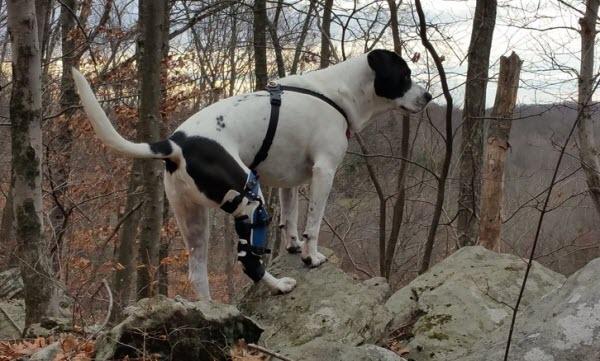
If you have a high energy dog, one that dives off of stairs and furniture, and is harder to control, you may be advised to use the brace a bit more. Now, we only suggest using braces during times that your dog is supervised. This is a medical device, and should not be worn without direct supervision. I would suggest starting out slow, just using the brace during walks and activities hours your veterinary technician will go over with you. Once your dog has been using the brace well, and you feel more confident, you can begin to increase the amount of time (hours) your dog uses the brace.
I still like to give breaks during the day, especially if there is a time they like to lay down and nap. For instance, using the brace for 2 to 3 hours in the morning, while they get the wiggles out, go potty, walk, and breakfast is perfectly fine. You may then opt to remove the brace during lunchtime, as most dogs calm down around this time. Then, you can place the brace back on in the afternoon, and remove prior to going to bed. This is just a suggested scenario, but again you do need to continue monitoring them with the brace.
We do not suggest any patient to wear the brace 8-12 hours a day, as anything that is worn that long on human or dog can cause skin irritation.
If your dog is pretty chill, relaxed, and only really active outside (such as giant breeds), then I would suggest using the brace just for activities. These can include walks, car rides, when someone comes to visit, playing with another dog, stairs, ect. If they spend most of their time laying down, it would not be comfortable to leave a brace on all day long. Let them get cozy, but we will be suggesting some Physical therapy activities to help prevent atrophy.
Put a sign outside your door, this will help discourage people from ringing the doorbell or knocking. Most dogs react to hearing a knock and doorbell, so if we can cut back on those times that will really help with preventing re-injury. Instead, put your phone number on the sign, so they can text you if someone arrives to visit.
Always feel free to speak to your service veterinary technician with any questions, that is what we are here for! Thank you, and give your dog a big hug for us!
You can contact us via our contact page or visit our Facebook page for more information.
Let Your Dog Recover With Our Custom Dog Knee Brace!
We’ve Helped Dogs All Around The World, Now We Want To Help Yours…
The Posh Dog Knee Brace is a 100% custom Dog knee brace, hand made only for your Dog. We make our custom brace with no casting. Our state-of-the-art brace for Dogs is very durable, waterproof, sand proof, and easily adjustable by customers. Our Veterinary Technicians provide personal live video supervision of measuring, and fitting of your Dog ACL brace in the comfort of your own home.
Dogs can be prone to injuries related to various physical activities. Understanding the types of injuries associated with specific activities can help dog owners take preventive measures and seek appropriate veterinary care when needed. Here are common activity-related dog injuries:
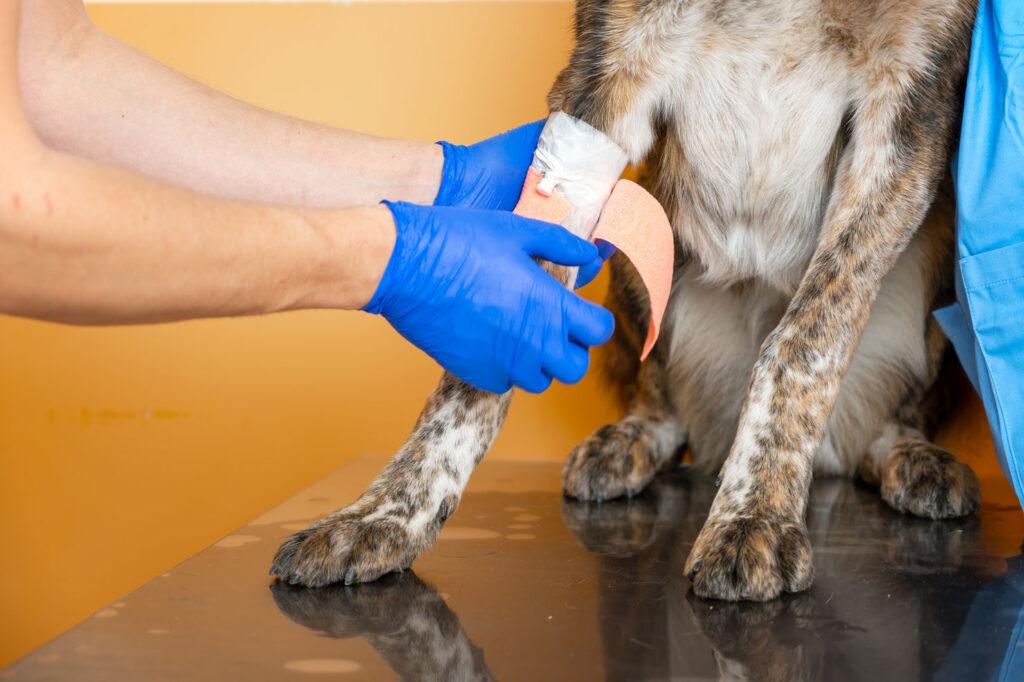
Preventing activity-related injuries involves being mindful of your dog’s limitations, ensuring they are adequately conditioned for the activity, and providing proper warm-up and cool-down periods. Regular veterinary check-ups can help detect and address any underlying health issues that might predispose a dog to injuries during physical activities. If an injury occurs, prompt veterinary attention is essential to ensure proper diagnosis and treatment.
For more information about related injuries or if you would like information about our brace contact us via our contact form or visit our Facebook page.
Hello! This is Nikki, Lead Veterinary Technician with Posh Dog Knee Braces. Today let’s go over how to break-in a new Posh Custom Dog Brace. First, we want to take things nice and slow. You wouldn’t take a brand new pair of boots to Disneyland resort for 10 miles of walking each day I hope. Neither should we put a custom brace on a dog for 8-12 hours without first working into that time. Just like in people, a dog’s skin needs some time to get adjusted to wearing something.
Over the next few weeks, as we gradually increase the times we have them in the brace, the skin will start to thicken and get stronger. Just like our feet do with a new pair of shoes. After a few short weeks, they should be able to tolerate wearing the brace longer and longer.

In the first 1-2 weeks, we suggest only using the brace during short leashed walks. This is to get your dog used to walking in the brace, to prevent soreness, and to get their skin used to having something touching. It can take a patient sometimes up to 3-4 weeks for the soreness in the muscle to get better, just like if we did physical therapy.
You wouldn’t want to run a 10K marathon with no practice or training, right? Even if your dog was walking 4+ miles each day before the injury, we now have atrophy and muscle loss (yes even if its only been a few weeks). Starting out with nice slow walks, and building up the times slowly, will really help prevent soreness and rubbing issues.
We typically don’t see rubbing sores with Posh, because we are so clear on our direction to our clients. Wearing the brace gradually more and more each week, really helps them adapt to having something touching their sensitive areas. The upper groin and ankle area seem to be the most common areas we see any irritation, and usually if the brace was worn for too long too fast. Doing 10-15 minutes twice daily for 2 weeks, then adding 15 minutes weekly to their walk schedule will really help.
We have this break-in schedule completely broken down for our clients in the handouts we send after the brace has been fit properly with a technician. A custom brace should never be worn right off without some sort of consultation, to ensure proper fit and make sure your dog is using the brace properly. Any company that does not do this is a red flag in my book.
Let me know if you have any questions about our break-in schedule! Please contact us via our contact page or visit our Facebook Page.
Nikki, Posh Lead Veterinary Technician
Reiki is a form of alternative therapy that originated in Japan and is based on the concept of channeling healing energy through the practitioner’s hands. While scientific evidence supporting the effectiveness of Reiki is limited, some dog owners and practitioners believe that it can provide various benefits for dogs. It’s essential to note that Reiki should not replace conventional veterinary care but can be used as a complementary approach.
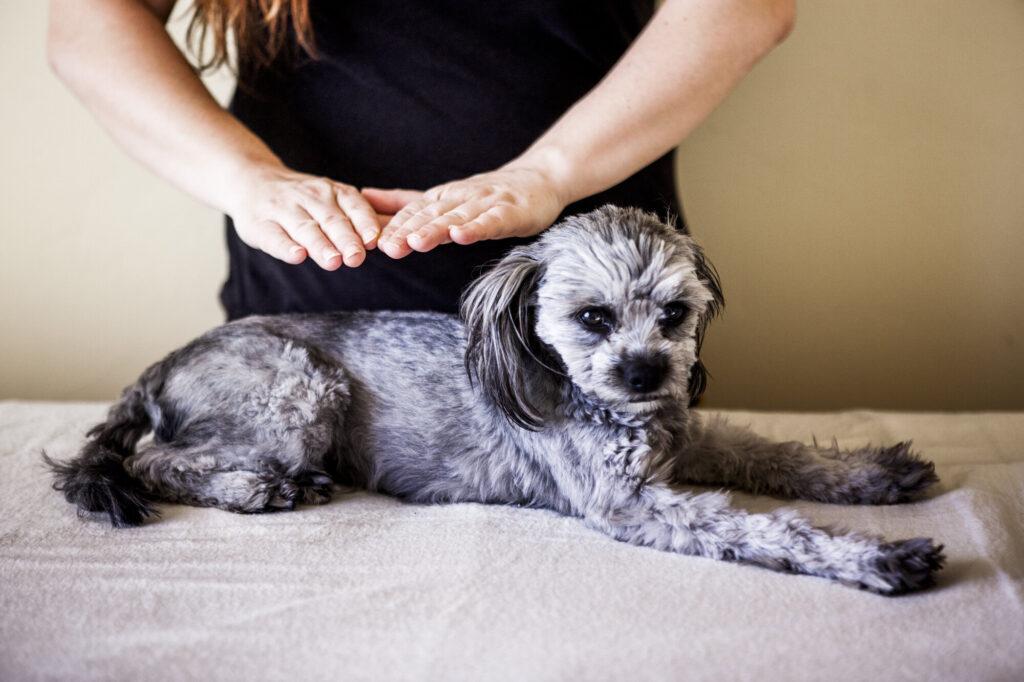
While some dog owners report positive experiences with Reiki, it’s important to approach it with an open mind and consult with a veterinarian before incorporating it into your dog’s care plan. Always prioritize conventional veterinary care for diagnosing and treating medical conditions.
For more information on how to help your dog recover with their injuries or if you are interested in a Posh Dog Knee Brace you can contact us via our contact page or visit us on Facebook.
Hey guys, this is Nikki lead Veterinary Technician with Posh Dog Knee Braces. Let’s talk about the cruciate ligament, and what it does for us. As the name states, the cruciate ligaments form a cross behind the dog’s knee. The Cranial Cruciate Ligament in dogs is the same as the anterior cruciate ligament (ACL) in humans. This is made up of many different fibers that work to attach the femur to the tibia, which keeps the tibia from moving.
This is why in order to diagnose a CCL rupture, your veterinarian will do what is called a “drawer test” in which they check the movement and shifting of the tibia. If the ligaments are healthy, there should be no movement, or positive drawer sign.
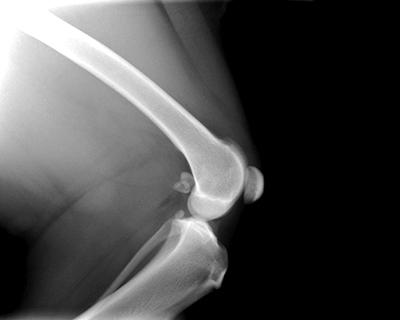
Trauma or degenerative disease to the ligament can damage some of the fibers that make up this ligament. Sometimes you may be told it is a “partial” or a “full” cruciate ligaments tear, however, this is impossible to fully know without going into the joint arthroscopically, or having an MRI done.
We can’t know if the ligaments are simply diseased and stretching more than they should, or fully ruptured which then puts strain on the meniscus. With a trauma, these fibers tear all at once, causing pain and inflammation, and more acute symptoms. Degenerative disease is like a fraying rope, those fibers break over time, and you may not notice the subtle signs. Or your dog may limp here or there, but not all the time.
Unfortunately, most ruptures in a dog are the result of long-term degeneration, where things get weaker and tear over a period of time. Genetics are one of the reasons for degeneration, these breeds include Labradors, rottweilers, boxers, west highland terriers, and newfoundlands. There are more breeds, but these are the most common. Some family lines can be checked out, and I would encourage asking about any history on a future puppy in one of these breeds. It can be detrimental to have a healthy 2 or 3 year old dog with bilateral CCL tears, and we do unfortunately see that.
Another factor to think about would be early spay or neuter. I have another blog on this subject if you would like more information, but to summarize we should not be spaying or neutering until a dog has reached maturity. By doing so, we cause the tibia to continue to grow, which can change the angle in the knee stretching the ligaments. At least a year as a minimum, some large breeds should be 2 years before sterilizing.
Fraying of the ligament can trigger a lot of internal things, such as pain and lameness. Usually with degeneration, there is already osteoarthritis present. The goal here is to stop the movement of the knee, either with a surgical procedure or the less invasive knee bracing options. Bracing will stop the movement of the tibial thrust, as well as acting as a shock absorber, allowing a patient to fully weight bear with the brace on. This will help with getting back to walks and a happy lifestyle.
The more osteoarthritis present, the less successful a patient will be with surgery. As the majority of cases are degenerative, bracing seems to be one of the better solutions. Please email us with any questions, and check us out on Facebook. Let’s help improve his life and yours with our Posh Dog Knee Brace. Custom Crafted Dog Knee Brace, is much more effective than a ready to wear or a soft dog ACL/CCL brace. You can contact Posh Dog Knee Brace via phone at 509-412-3065.
Knee injuries are relatively common in dogs and can lead to varying degrees of pain, lameness, and mobility issues. One of the most prevalent knee injuries in dogs is a torn cranial cruciate ligament (CCL), which is analogous to the anterior cruciate ligament (ACL) in humans. The CCL helps stabilize the knee joint and prevent excessive movement between the femur and tibia bones.
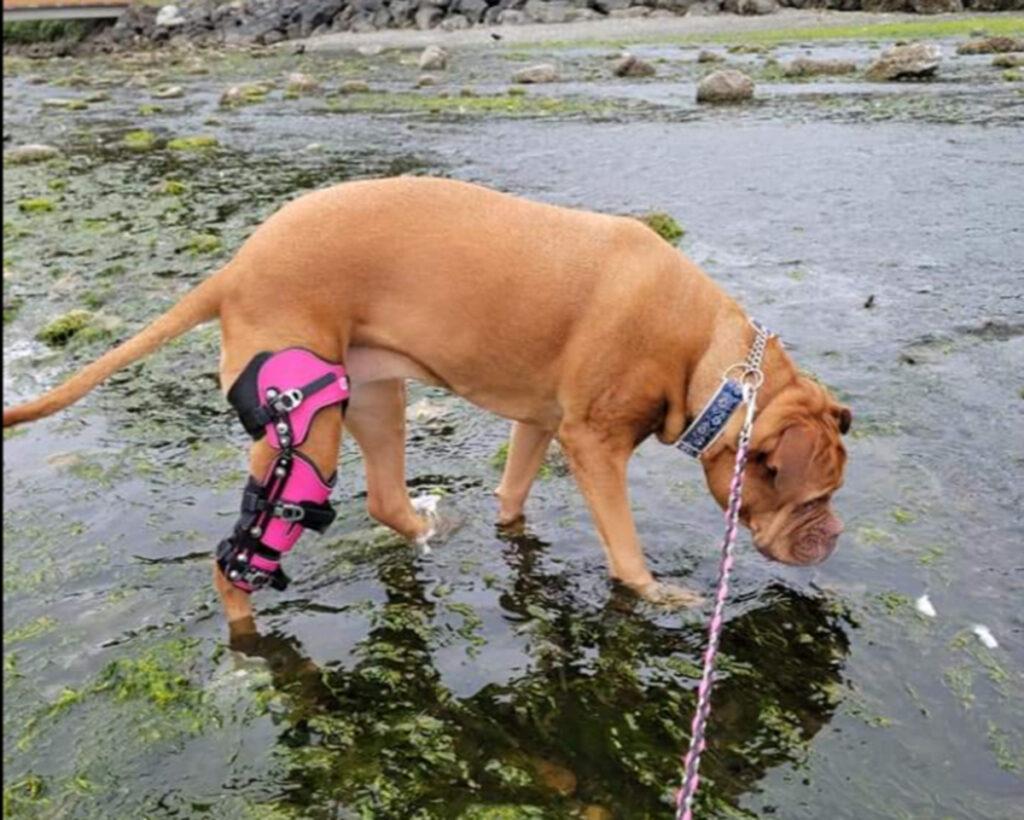
If you suspect your dog has a knee injury or is experiencing any of the above symptoms, it’s essential to seek veterinary attention promptly. Your veterinarian will conduct a thorough physical examination, possibly including X-rays or other imaging tests, to diagnose the specific knee injury and develop an appropriate treatment plan.
The choice of treatment will depend on the severity of the injury, the dog’s age and overall health, and the veterinarian’s recommendation. Early diagnosis and appropriate treatment are crucial for improving the dog’s comfort and mobility and preventing further joint damage or complications.
If you are interested in purchasing a Posh Dog Knee Brace you can order from our shopping page or if you have questions about our brace you can reach out to us via our contact form or visit our Facebook page for more information.
The amount of exercise a dog needs can vary depending on factors such as their breed, age, size, and overall health. However, most dogs require a combination of physical and mental exercise to stay healthy and happy. Here are some general guidelines for the amount of exercise dogs need based on their life stage:
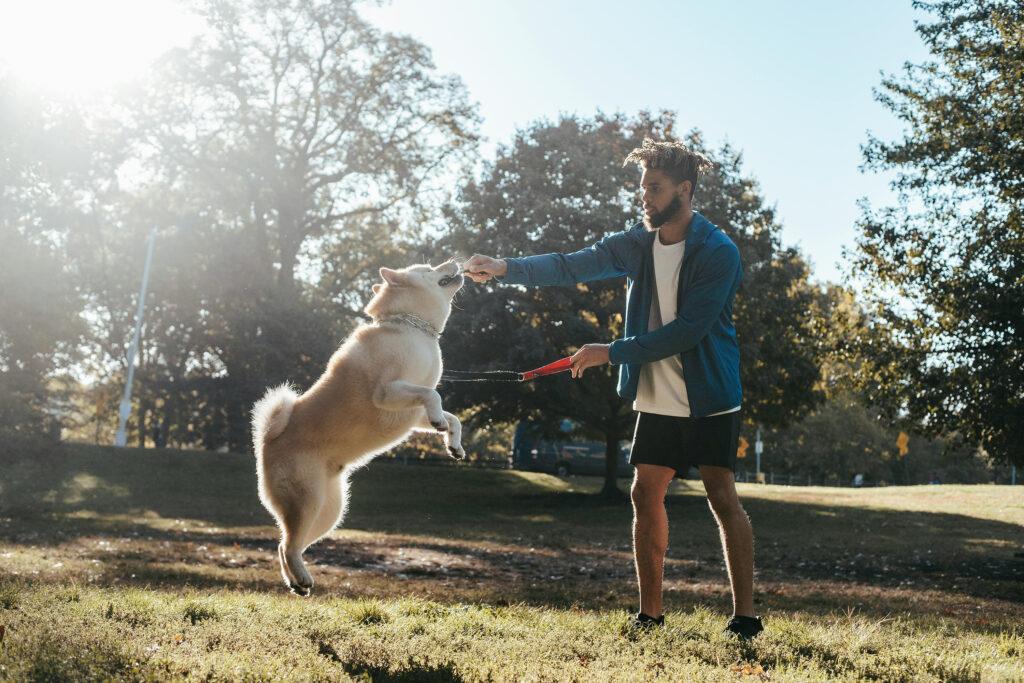
Puppies: Puppies have boundless energy and need frequent, short bursts of play and activity throughout the day. As they grow, their activity can gradually increase. Aim for a total of 30 minutes to 2 hours of exercise daily, spread across several short play sessions.
Adult Dogs: Adult dogs generally require around 30 minutes to 2 hours of exercise each day, depending on their breed and activity level. Breeds with high energy levels, such as Border Collies or Retrievers, may need closer to 1-2 hours of activity daily, while smaller or less active breeds may be content with 30 minutes to an hour.
Senior Dogs: Older dogs may have reduced energy levels and mobility, but they still benefit from regular exercise. Lighter and shorter exercise sessions are more appropriate for seniors, typically around 30 minutes per day. Keep in mind that senior dogs may need more frequent breaks and slower-paced walks.
In addition to physical exercise, mental stimulation is crucial for all dogs, regardless of age. Mental exercises, such as puzzle toys, training sessions, and interactive games, help keep their minds sharp and prevent boredom.
Remember that these are general guidelines, and individual dogs may have different needs. It’s essential to observe your dog’s behavior and adjust their exercise routine accordingly. Some signs that your dog may need more exercise include restlessness, excessive barking, destructive behavior, or weight gain. On the other hand, if your dog appears tired, lethargic, or is experiencing difficulty exercising, consider reducing the intensity or duration of their activities.
If you have any questions you can contact us via our contact page or visit our Facebook page for more information.
Today I would like to talk about recommended activity levels with a brace or CCL tear. It is still important to remember that this is not a race. Recovery from a CCL takes time, which is why we use a gradual increase in activities.
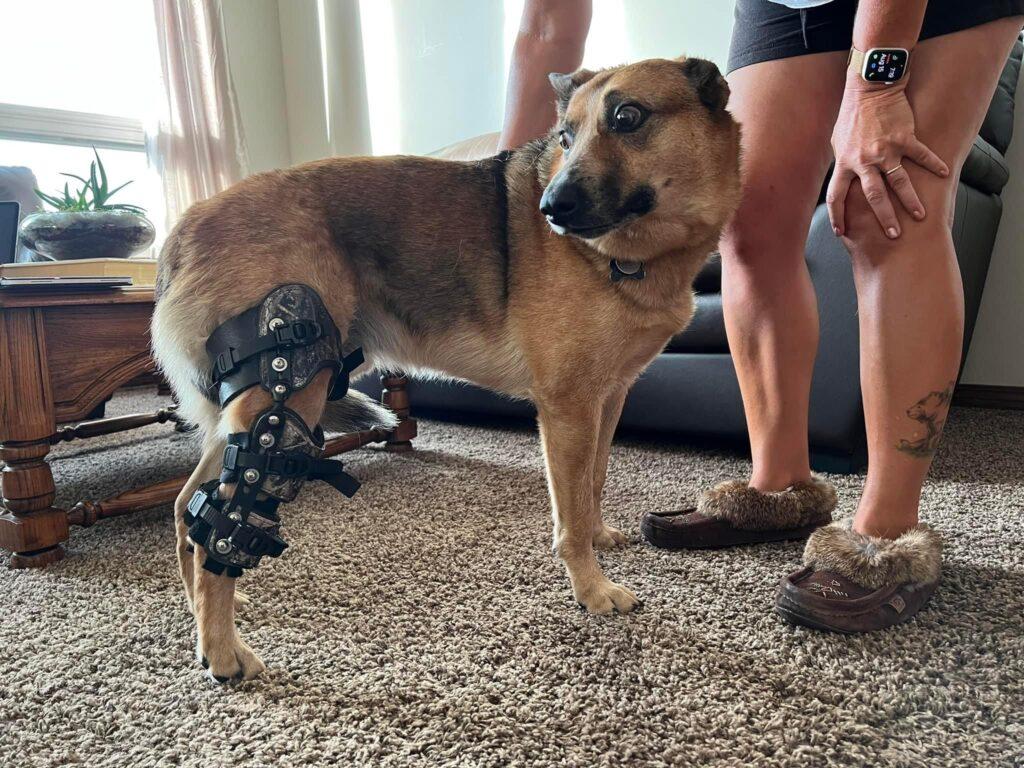
Initially, we start with walks and light physical therapy and massage. Gradually, we can increase activities, such as adding hills or inclines to the walk, sit stands, more muscle building activities.
It is not recommended to let your dog run off leash while in recovery. This can lead to injury of the other leg potentially. Braced walks are meant to be nice and slow, not a jog. The goal is to have your dog placing full weight down on his leg. If you walk or run too fast, they will skip and not place full weight on the leg.
We will get to a point where your pup can play off leash, but ask first, and take things slow. Feel free to email or send in a contact request with any questions, we are happy to help!
Give Your Dog a Big Hug From Us!
Nikki, Posh Lead Veterinary Technician
Looking for more information about our Posh Dog Knee Brace contact us via our contact form or visit our Facebook Page.
For dogs to maintain their physical and mental health, regular dog exercise is crucial. To avoid injuries, it’s important to select workouts that are suitable for your dog’s age, breed, size, and degree of fitness. The following canine workouts and injury prevention advice:
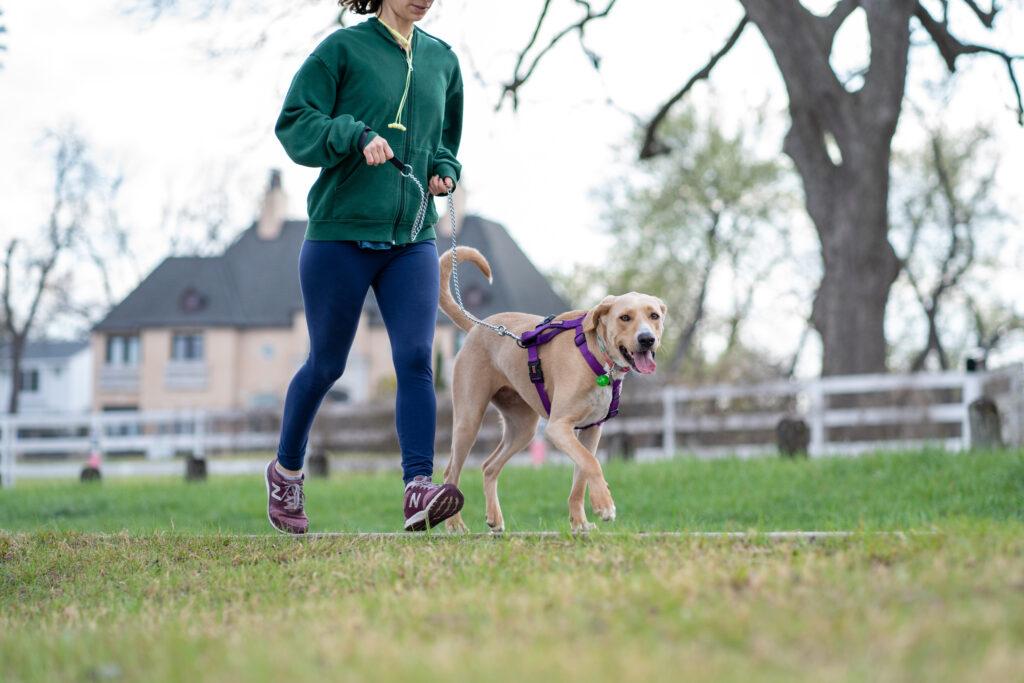
If you are interested in more information you can contact us via our contact page or visit our Facebook page.
The main difference between a cold pack and a hot pack for arthritic dogs lies in their application and the therapeutic effects they provide. Both cold and hot packs are used to manage arthritic pain and inflammation, but they serve different purposes and are applied at different stages of the condition. Here’s a breakdown of the differences:
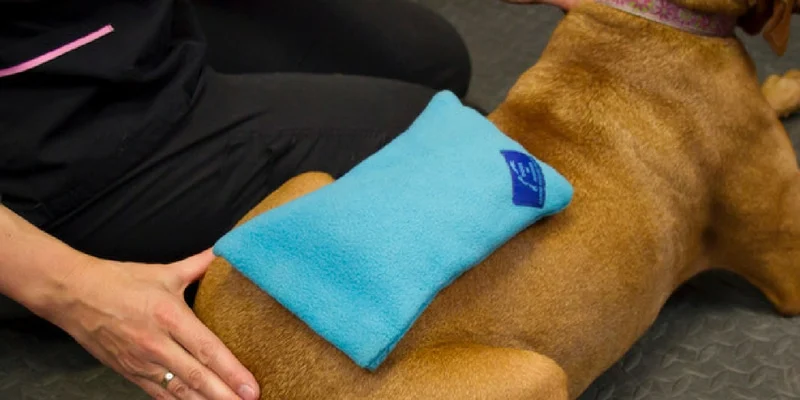
It’s essential to consult with your veterinarian before using either cold or hot packs on your arthritic dog to ensure that it is appropriate for their specific condition and to determine the proper application and duration of therapy. Additionally, other complementary therapies and medications may be recommended to provide comprehensive pain management and improve your dog’s overall comfort and mobility.
To learn more you can contact us via our contact form or visit our Facebook page.
Hey guys, this is Nikki the lead veterinary technician with Posh Dog Knee Braces. Today, let’s talk about how being overweight can affect our joints. As you know, the more weight we have, the more pressure we put on our joints and internal organs. This can put the body in a state of inflammation, as well as predispose us to many ailments and orthopedic issues. We are making our joints work much harder, which starts a vicious cycle on inactivity. The more the joints are sore, the less your dog will want to walk, which can cause the muscles to atrophy. Pretty soon we have a pup with less muscle, and much more prone to physical injuries like CCL tearing.
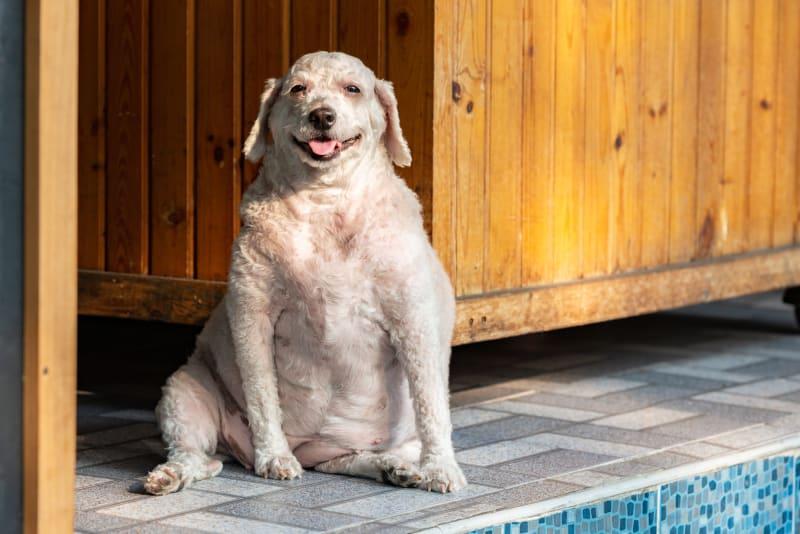
Not only does weight gain affect the organs and joints, but it also can shorten life expectancy by quite a bit. Unfortunately, this is not going to be a quick fix situation. It is much easier to get the weight off a younger dog than one that is aging. Prevention is much easier than treatment, especially if your dog is spayed or neutered, which can increase the chances of becoming overweight.
If your dog is in the top weight percentile, and does not yet have any limping issues, it’s time to get serious about weight loss. Things you can do first is check everything that you are feeding your dog every day. I want a list of each and every treat, kibble, and snack. Small things like swapping daily treats for a carrot or sweet potato stick, ect can help, as well as increasing exercise. If you have a dog that does not like to exercise, starting slow is key. Maybe 15 minutes a few times daily will really help. It is important not to skip exercise. Walking and swimming is great.
Second, changing diet is next. If you are feeding a diet that has a lot of carbohydrates, and less protein, it may be time to switch. I like diets with a good quality protein source, not by products. Make sure you are not feeding grocery store foods, unless you absolutely have to. There are many good quality foods out there. If you are already feeding a good quality food, make sure you are not feeding too much.
If you are not sure what to be feeding your dog to help, please consult with your veterinarian, maybe schedule a time to go over the nutritional needs of your dog with your Dr. or a veterinary technician. They may have a specific diet they recommend.
If you have an overweight dog that already has a limp or headed for a CCL tear, but not there yet, then I would strongly suggest finding a physical therapy clinic, one with hydrotherapy. This will help strengthen the leg, and loose weight.
Please call or email with any questions! www.poshdogkneebrace.com or visit our Facebook Page.
Hey guys, this is Nikki Lead Veterinary Technician with Posh Dog knee Braces. This is one of my most common questions asked will my dog need a knee brace forever for a CCL/ACL tear?, and I would like to dive deeper to answer this question, as there is more to the answer than simply No.

First off, the majority of my patients will use the posh dog knee brace for about 9 months, sometimes up to 12 months if they are a larger breed or have a minor meniscal tear. We know that scar tissue is mature by the 9-12 month point, and at the juvenile stage around month 2-3. If someone tells you that your dog will be permanently using the knee brace, they are simply misinformed. There are actually quite a few studies in both humans and animals, proving the timeline of scar tissue formation.
In surgical sites, or areas of soft tissue, scar tissue can form much faster, forming a thickened scar within weeks. This is different from the fibrous tissue that forms in a joint, and gives us regained stability. Let me ask you this, have you ever sprained your ankle or injured a joint?
Did you use a splint or a knee brace to help that joint recover? I know I have. Depending on the joint, and amount of muscle you were able to keep with physical therapy, also plays a key role in the longevity of using the brace. We do not want to keep the brace on forever, however, in some severe arthritis cases, or luxating patella issues, bracing longer term as needed may be necessary.
How do you know when it is time to take your dog out of the knee brace? Time will tell on this one. Most dogs are ready to go, and fully weight bearing by 9-12 months. However, if you were unable to complete the physical therapy recommendations during the recovery times, your dog may need longer in the brace while they acclimate slowly to walking without the brace on.
This needs to be a slow weaning process, so as not to cause a re-injury. Take your dog for a nice leash walk, without the brace. If you dog does great, and has no sign of a limp or gait that is off, then you can continue to leash walk without the brace for a bit longer until you feel comfortable letting your dog resume activites.
Some dogs may need a little longer than 12 months, such as patients with meniscal tears or arthritis, or if there was a re-injury during the healing process. This is still not forever, I would take things month by month until you are successful at walks without the brace on. Our service technicians are happy to answer any questions you may have about this process, and there is really not a wrong answer. If you feel more comfortable having your dog wear the brace longer, and your dog is doing great, that’s ok!
I would suggest our Posh led support group on Facebook, where you can talk with thousands of other clients who have all used the posh brace to recover. This is a great place to learn more about what to expect, and get great advice from both our technicians and previous customers.
To sum everything up, we do need to make sure to use the brace as directed for at least 9 months, but that is usually adequate for the majority of our clients. Please check out our website, poshdogkneebrace.com, for further tips and information that may also be very helpful, you can also reach out to our facebook page as well for information.
Today we will go over some common asked questions about custom braces for dogs.
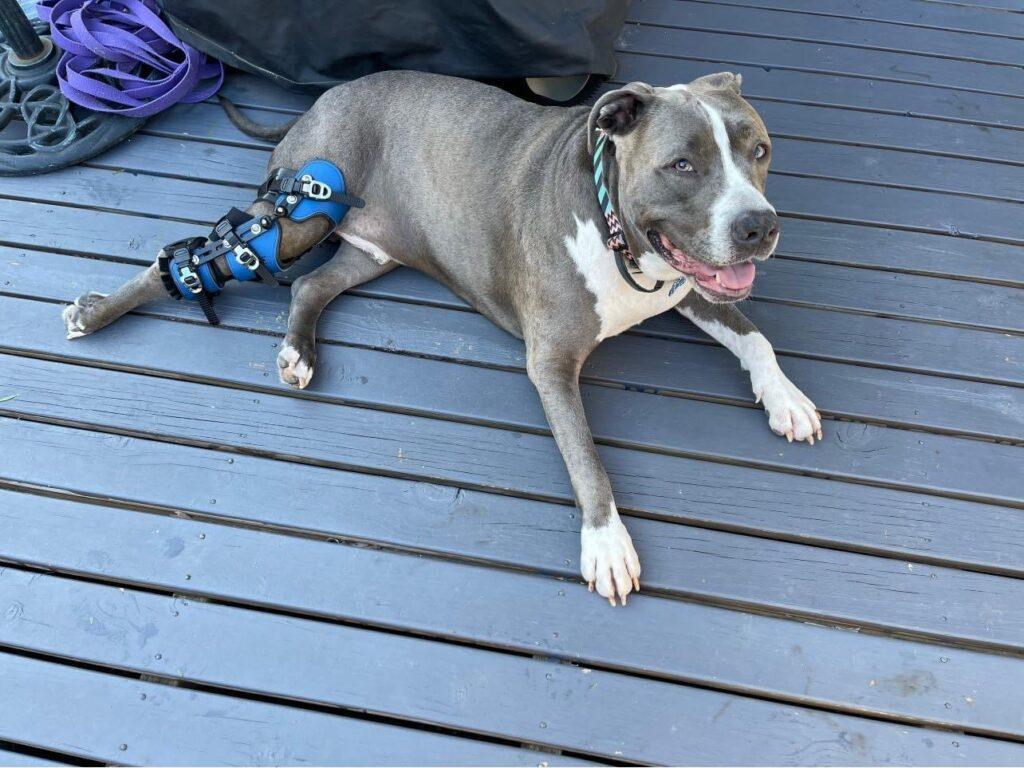
Why does our brace cost more than the over the counter options for $400-$500?
This is a good question! First off, most custom orthotics will be in the $900-$1200 range, as there is much more involved in the production than the over the counter options. For instance, with our brace each client gets 4+ hours of customer service with our veterinary technicians, both guiding them in measurements, fitting calls, rehab assistance, and supplement/diet help. There is also a lot more production time needed for custom products, and we do not start until we have the measurements from the patient. Over the counter braces are a “one brace fits all” product, so they have sized like small, medium, and large.
They do not take into account patients that are more bow legged like our staffies, or patients that need the top shell brought down a bit more to accommodate shorter legs. Plus, we do have a warranty on the parts of our brace, where a non-custom product is not only non refundable, but there is no warranty. The buyer essentially takes on all of the risk. I have many patients that have purchased a non-custom brace first, only to find it did not fit well, and were stuck. Then, they went with our Posh Dog knee Brace, and loved the custom fit, non sliding option.
Does a custom product have straps that go over the back?
No, custom braces will not have straps or stirrups that hold them in place. This is because we are a direct fit to the patient. Non-custom products are not made for your dog’s leg, so they must be held up by straps and stirrups. Our brace utilizes a hock wrap, that goes around the ankle, to help keep things from slipping down. This, and our unique strapping system, make it so our brace is much more simple to use.
Do custom dog braces need to be casted? My vet told me only to use casted braces
No, at Posh Dog Knee Braces we use a proprietary online program, that allows us to make a digital model of your dog’s leg, using specific measurements. This is why we have a veterinary technician watching and helping each patient take the measurements that we need. Our process is much faster and easier than casting, and production typically only 3-4 business days, with express shipping.
What is the materials of a custom vs. non custom brace? Are they made of the same stuff?
Again, great question. A non custom, over the counter brace is made of cheaper materials, such as neoprene and sometimes a cheaper metal hinge. This means they are not going to last you long, and will not be waterproof. Our Posh Brace is made of only the best orthotic materials, similar to pediatric orthotics, so that they are both durable, comfortable, and easily cleaned. Our dog knee brace can also be used in hydrotherapy.
For more information you can reach us via our contact form or visit our Facebook Page.
Hey guys, Nikki with posh dog knee braces here. So, first of all I can’t stress enough the need to do some form of physical therapy. We send every patient home with a 12 week recovery calendar and exercises, however, we need you to keep those up for the full 9 months. Whether you find a holistic or physical therapy clinic to help you with water treadmill or PT, you need to keep you dog active in some way.
Lack of activity will cause a joint to “lock up” after the scar tissue has formed, meaning there is not going to be the same amount of range of motion there. There also can be loss of muscle. The brace alone is not enough to build muscle, you will need to keep walking your dog, and doing some form of exercise program. This is needed whether you do surgery, Conservative management, or bracing. Doing nothing will result in loss of muscle, loss of range of motion, and most likely arthritis and pain down the road.
We have a lovely list of holistic veterinarians and rehab clinics around the US and in Canada, so reach out if you are struggling to find a clinic. The clinics on our list are partners with posh, and know how to treat our patients, as well as measure and fit the brace if needed. We do have some things we can have you do from home as well, if PT is just not in the budget. I am happy with walks, simple exercises, and passive range of motion.
What is PROM? This is you gently bending and flexing the knee, as well as the hip. I have videos we send to you on how to do this stretching, but this is key to keep flexibility in the joint, and not end up with lack of movement there.
Please let us know if you have any questions, poshdogkneebrace.com or visit our Facebook Page. Thanks!
Hey guys, this is Nikki Lead Veterinary Technician with Posh Dog Knee Braces. Today, let’s talk about Cranial Cruciate Ligament Repair (CCL/ACL) tears in a dog, and what your options are. First of all, if your dog is limping on the hind leg, be sure to get a diagnosis from your veterinarian before making any decisions. Once that takes place, be firm with your Veterinarian if needed and ask for the exact diagnosis. If they feel that your dog has a Cranial Cruciate Ligament tear, or CCL tear, then you do have some decisions to make moving forward. Let’s go into the options, and the pros and cons, as well as long term expectations.
First off, depending on your veterinarian, they may refer you to a specialist to verify the diagnosis. This is completely up to you, but do know that if you go to a specialist, they are typically surgeons, and will not be happy without scheduling your dog for surgery. Please know that you can say no. I can’t stress enough how important it is for you to take a breath, and go over all options before signing that dotted line.
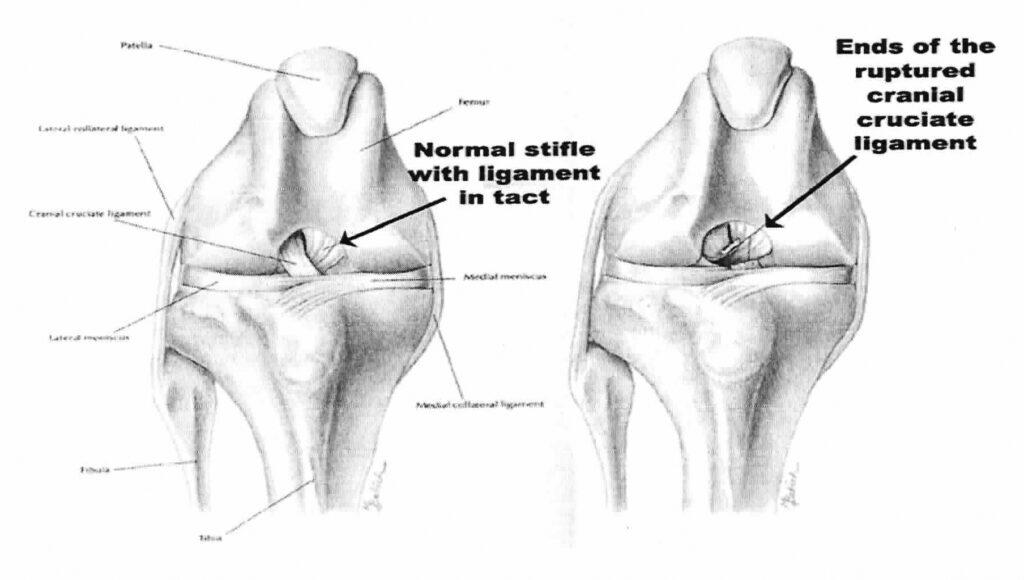
Choosing to do just conservative management, with no support or surgery. This seems to be gaining momentum and popularity, because obviously options can cost money. There are supportive things to do, such as keeping your dog in a kennel, leash walks outside, supplements, acupuncture, laser, prp, ect. While this option is better for the budget, it is not for the busy owner, or owners with small children and other pets. While it sounds great, reality is that there is a great chance your pup will continue to re-injure their knee. At some point, the door will open, and your dog will want to run.
Someone will forget, your dog looks like he is dong better at 3 months, and in he comes with the leg hiked all the way up to the groin. Sound familiar? This can be a tough cycle, and the bones in the knee are still able to move, causing pressure on the meniscus as well increasing your dog’s chance of arthritis down the road. So, can a knee heal with conservative management alone? Possibly, but there could be long term issues if you do not do passive range of motion, PT, and exercising along with CM alone.
This is by far my favorite option, from years of experience working with orthopedics. Using an orthotic Brace in conjunction with PROM and PT, as well as supplements and support. Now I am not talking about the cheap over the counter neoprene braces that have a spiderweb of straps connecting to the harness or back, those are no better than just letting the knee recover alone.
I am talking about a custom made premium orthotic brace, such as the Posh Dog Knee Brace. Posh Brace fully stabilizes the knee, allowing for range of motion and squatting, while also acting as a shock absorber for the meniscus. This is going to help give a smoother recovery, and allow that scar tissue to form without a lot of re-injuries. Thus, this is one of the safer options, and definitely still less than surgery.
Tightrope, lateral suture, or extracapsular repair. This is the cheapest of the surgical options, and should only be used on patients under 30-40lbs, as the suture has double the chance of failing in larger breed patients. This method usually is in the $2k-$3k ballpark range now, and is literally using fishing line/or suture to wrap around the knee joint to keep things in place. There are several ways this can and usually does fail. The crimps can come off, the suture can break, the suture can slip, ect.
These patients are immobile for months, and do get a lot of atrophy in the joint. This seems to be sore to recover from, and without a brace post op, your dog is going to need to be kenneled for weeks to months, to allow for scar tissue to properly form. This technique is similar to if you braced, however, without the full stabilization and support, and double the cost.
TPLO or TTA surgery. Both of these will be suggested by your vet or surgeon, usually first. They both entail cutting of the tibia bone, and re-alignment using a plate and screws. This is permanent, and there is no going back if something doesn’t go the way it was meant to. I always save this for my last option, as it is extremely invasive, expensive, and does not give a guarantee of working. Too many patients have had lifelong lameness due to choosing this option, and are not able to recover fully.
There are many weeks needed for kenneling, so the leg will atrophy. This also causes overcompensating on the good knee, which again increases the chances of another CCL tear in that leg. If surgery does go well, and you are able to do a full Physical Therapy Program post op with a professional, your dog may have a good outcome, but this is not without risk.
Please email me at poshintake1@gmail.com if you would like to ask more questions about Cranial Cruciate Ligament Repair, CCL/ACL tears in dogs, and what the best options are for your pup. You can also contact via our forms or visit our Facebook page.